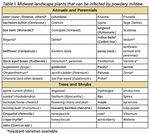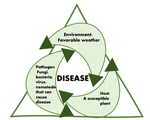Powdery Mildew - Purdue Extension
←
→
Page content transcription
If your browser does not render page correctly, please read the page content below
Botany & Plant Pathology
ag.purdue.edu/BTNY
BP-5-W
Figure 1. Powdery mildew is readily diagnosed by the white, powdery coating on the leaf surface. All Photos by Janna Beckerman,
unless otherwise noted.
DISEASES OF LANDSCAPE PLANTS
Powdery Mildew
Powdery mildew is a common fungal disease that can attack a wide range of plants
(Fig. 1, Table 1). There are thousands of species of powdery mildew fungi; most are very
Janna Beckerman specific to their plant host, meaning powdery mildew of lilac will not spread to phlox or
other annual and perennial flowers.
Department of Botany
and Plant Pathology,
Purdue UniversityBP-5-W DISEASES OF LANDSCAPE PLANTS - Powdery Mildew
Figure 2. Powdery mildew infection can cause deformity and distortion on leaves Figure 3. Powdery may present without the characteristic ‘powdery’ coating,
and stems. making diagnosis difficult. These sedum were later confirmed to be infected
by powdery mildew.
Symptoms
Powdery mildew is easily diagnosed on most plants The disease triangle is a useful tool to understand
by its characteristic coating of “powder” that consists powdery mildew (Fig. 4). Symptom severity depends
of the disease-causing fungus. The disease is often upon how virulent the pathogen is coupled with the
observed (but not limited to) the upper leaf surface (Fig. susceptibility of the host plant (Fig. 5). Plant age,
1). Powdery mildew rarely causes serious damage to its health, and vigor (due to too much or too little fertilizer)
host, but infection by the fungus can discolor leaves, also impacts disease severity. Finally, environmental
causing those leaves to die and/or drop. Powdery conditions affect both the plant and the fungus, with
mildew can also infect, disfigure and deform shoots and hot, dry weather causing plant stress, while providing
flowers (Fig. 2). In some rare instances, the characteristic conditions that favor the powdery mildew fungus to
sign of powdery mildew infection, the white powder infect.
caused by spores and mycelia, may not be easily visible
without a microscope on some plants (Fig. 3). Repeated
infections can result in weak, distorted stems, fewer Biology and Disease Cycle
leaves, and reduced flowering. Although unsightly, A variety of microscopically distinct fungi cause
powdery mildew is rarely fatal, and even dieback is rare. powdery mildew, so while the white growth covering
different plants may look the same to the naked eye, the
fungi causing powdery mildew on one plant are usually
microscopically and biologically distinct from those on
another plant (Fig. 6). In the Midwest, powdery mildews
frequently infect azalea, buckeye, lilac, rose, tulip-tree,
Figure 4. The plant disease triangle is a model to explain how the host, pathogen Figure 5. Veronica is just one plant species that produces a diversity of
and environment interact resulting in disease. symptom responses to powdery mildew infection.
2BP-5-W DISEASES OF LANDSCAPE PLANTS - Powdery Mildew
Figure 6. Chasmothecia of powdery mildew pathogens on dogwood (left, by Bruce Figure 7. Closeup of powdery mildew infection. Micrograph by Tom Creswell.
Watt) and buckeye (right, by Christopher Detranaltes).
along with numerous annuals and perennials (Table 1). planting, allow for adequate spacing in the appropriate
In most cases (some perennials being the exception), site (i.e., too much or too little sunlight can stress plants
the pathogen is host specific, meaning that the rose and predispose them to severe disease).
powdery mildew pathogen cannot infect lilac, or vice
versa.
Water inhibits spore germination for most powdery
mildews, so overhead watering of the leaves during the
In the spring, chasmothecia (specialized spore day and when humidity is low greatly inhibits infection
structures that look like Koosh balls) that developed on and can protect the plant. Using water to control
previously infected plant material, rupture and release powdery mildew is moderately effective only if other
fungal spores (Fig. 6). Wind carries these spores to leaf diseases are not a problem. Because most other
newly emerging, susceptible tissues where they begin pathogens do require water on the leaf surface to infect,
to grow on the surface, and into the upper layer of the take care that powdery mildew prevention occurs at the
leaf. Successful infection results in asexual reproduction, expense of another foliar disease!
with the fungus producing columns of spores capable of
causing repeated infections (Fig. 7). Powdery mildew seldom warrants chemical control
in the home landscape and is more often an issue of
nursery and greenhouse production. When addition
Fungal growth, coupled with spore production
disease control in desired, materials with low
throughout the growing season, give infected leaves
environmental impact, such as horticultural oils or neem
a white- to light gray characteristic dusting (Fig. 1).
oil can prevent infection when applied to green tissue
Powdery mildew is most prevalent when temperatures
on the plant. Such applications can remain effective for
are cooler and humidity is high, or when it is extremely
dry. Powdery mildew pathogens are some of the only
fungal organisms that can germinate and infect in the
absence of free water
Management
Cultural practices aimed at alleviating high humidity can
help prevent the disease or decrease its severity. Such
practices involve increasing air circulation and light
penetration by pruning and thinning plants to reduce
overcrowding in the landscape.
When selecting new plants, choose those that have
powdery mildew resistance (Fig. 8). There are many
powdery mildew resistant varieties of trees, shrubs,
perennial and annual plants. See ‘Disease Resistant
Figure 8. Many plants are selected or bred for powdery mildew resistance.
Annuals and Perennials in the Landscape’. When
3BP-5-W DISEASES OF LANDSCAPE PLANTS - Powdery Mildew
7 to 14 days in the home landscape
(depending upon plant growth and
rainfall), but will likely require repeated
reapplication. Do not apply these
products when temperatures are
above 85°F.
For greenhouse or nursery production,
more products require reapplication on
a 7-14 day schedule (Table 2). Always
read and follow product labels to make
sure the crop is on the label and for
the site of use. If addition control is
needed, apply a fungicide on a regular
schedule as the label recommends
until conditions change.
Most products labeled for powdery
mildew control are available only
to certified commercial applicators,
not homeowners. Table 2 lists all
fungicides labeled for powdery mildew.
Products set in parentheses are
available for homeowner use.
For deciduous shrubs that have
repeated, yearly infections, a dormant
fungicide such as lime-sulfur may be
applied in the fall, and again in early
spring before new growth begins (do
not use lime-sulfur on sulfur-sensitive
plants like viburnum, grape, and many
garden vegetables.). Read all chemical
labels for recommended plants for
treatment before purchasing and using.
Label information is the final authority.
Read all fungicide labels carefully and
apply only as directed. Always read
and follow product labels to make sure
the crop is on the label and for the
site of use. Inclusion does not imply
endorsement or recommendation.
Find Out More
Find more publications in the Diseases
of Landscape Plants series by visiting
the Purdue Extension Education Store
at www.extension.purdue.edu/new.
Find out more at
purdue.edu/extension THE EDUCATION STORE
edustore.purdue.edu
An Equal Access/Equal Opportunity University March 2022
4You can also read



























































